非谓语动词(基础讲解)
- 格式:doc
- 大小:57.50 KB
- 文档页数:10
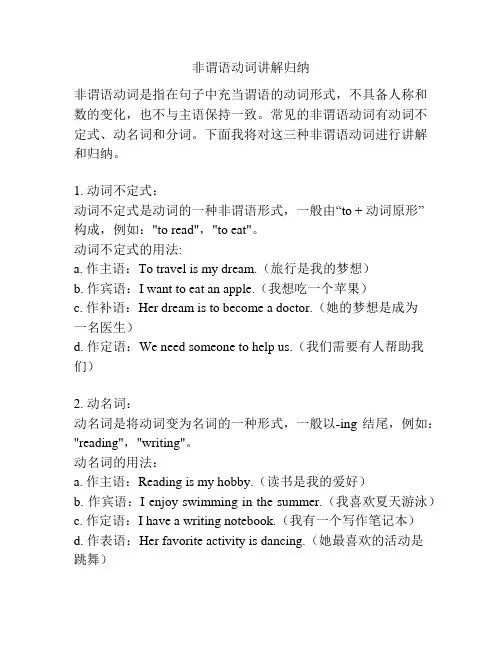
非谓语动词讲解归纳非谓语动词是指在句子中充当谓语的动词形式,不具备人称和数的变化,也不与主语保持一致。
常见的非谓语动词有动词不定式、动名词和分词。
下面我将对这三种非谓语动词进行讲解和归纳。
1. 动词不定式:动词不定式是动词的一种非谓语形式,一般由“to + 动词原形”构成,例如:"to read","to eat"。
动词不定式的用法:a. 作主语:To travel is my dream.(旅行是我的梦想)b. 作宾语:I want to eat an apple.(我想吃一个苹果)c. 作补语:Her dream is to become a doctor.(她的梦想是成为一名医生)d. 作定语:We need someone to help us.(我们需要有人帮助我们)2. 动名词:动名词是将动词变为名词的一种形式,一般以-ing结尾,例如:"reading","writing"。
动名词的用法:a. 作主语:Reading is my hobby.(读书是我的爱好)b. 作宾语:I enjoy swimming in the summer.(我喜欢夏天游泳)c. 作定语:I have a writing notebook.(我有一个写作笔记本)d. 作表语:Her favorite activity is dancing.(她最喜欢的活动是跳舞)3. 分词:分词是动词的一种非谓语形式,一般以-ing或-ed结尾,分别称为现在分词和过去分词,例如:"running","cooked"。
分词的用法:a. 现在分词作定语:The running water is very clean.(流动的水很干净)b. 过去分词作定语:The cooked chicken smells delicious.(煮熟的鸡肉闻起来很香)c. 分词作伴随状语:Hearing the news, she smiled happily.(听到消息,她高兴地笑了)需要注意的是,非谓语动词的形式可以有时态和语态的变化,如不定式可以有完成和进行的形式,动名词可以有进行和完成的形式,分词可以有进行、完成和被动的形式。
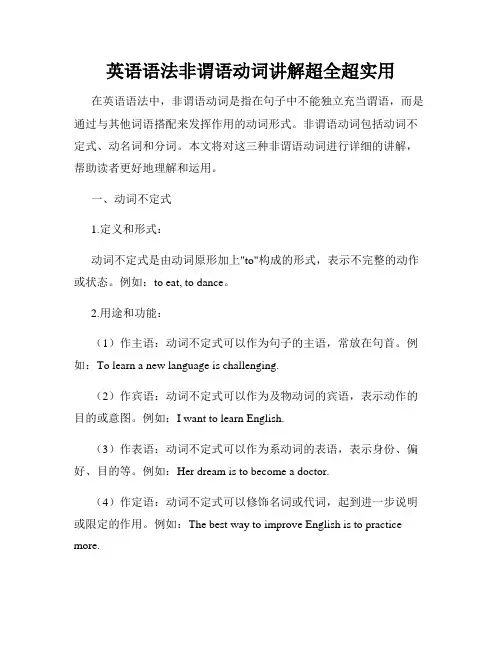
英语语法非谓语动词讲解超全超实用在英语语法中,非谓语动词是指在句子中不能独立充当谓语,而是通过与其他词语搭配来发挥作用的动词形式。
非谓语动词包括动词不定式、动名词和分词。
本文将对这三种非谓语动词进行详细的讲解,帮助读者更好地理解和运用。
一、动词不定式1.定义和形式:动词不定式是由动词原形加上"to"构成的形式,表示不完整的动作或状态。
例如:to eat, to dance。
2.用途和功能:(1)作主语:动词不定式可以作为句子的主语,常放在句首。
例如:To learn a new language is challenging.(2)作宾语:动词不定式可以作为及物动词的宾语,表示动作的目的或意图。
例如:I want to learn English.(3)作表语:动词不定式可以作为系动词的表语,表示身份、偏好、目的等。
例如:Her dream is to become a doctor.(4)作定语:动词不定式可以修饰名词或代词,起到进一步说明或限定的作用。
例如:The best way to improve English is to practice more.(5)作状语:动词不定式可以表示时间、目的、方式等状语的作用。
例如:I went to the park to relax.3.特殊用法:(1)省略to:在某些情况下,不定式的to可以省略,例如在助动词let、make、help等后面。
例如:Let me go.(2)动词不定式的时态:动词不定式没有人称和数的变化,但可以根据不同的时间来使用不同的时态。
例如:I want to go shopping.(现在时态)I wanted to go shopping.(过去时态)二、动名词1.定义和形式:动名词是由动词加上-ing构成的形式,可以作为名词使用。
例如:swimming, running。
2.用途和功能:(1)作主语:动名词可以作为句子的主语,常放在句首。


⾮谓语动词⽤法详细讲解⾮谓语动词⽤法详解动词的⾮谓语形式有三种:不定式、动名词和分词(⼀)不定式不定式由“to⼗动词原形”构成,其否定形式是“not to do ” ?不定式可以带宾语或状语构成不定式短语,没有⼈称和数的变化,但有时态和语态的变化?不定式可作主语、宾语、状语、表语和定语,但不能单独作谓语?不定式的逻辑主语有时⽤“for⼗名词或代词宾格”构成.1 ?不定式的⽤法:1)作主语.不定式短语作主语时,往往放在谓语之后,⽤it作形式主语?例如:To see is to believe .It is right to give up smok ing2)作宾语.不定式短语作宾语时,如果还带有宾语补⾜语。
往往把不定式宾语放在宾语补⾜语之后,⽽⽤it作形式宾语.例如:He wan ted to go .I find it interesting to study work with him.3)作宾语补⾜语.例如:He asked me to do the work with him.注意 :在feel,hear,listen to,look at,notice, observe,see,watch,have, let,make等词后的补⾜语中,不定式不带to.但是这些句⼦如果变成被动结构时,就必须带to.例如I ofte n hear him sing the songHe is ofte n heard to sing the song注意:不定式动词在介词but, except, besides后⾯时,如果这些介词之前有⾏为动词do的各种形式,那么,这些介词后的不定式不带to,否则要带to.⼥⼝:She could do nothing but cry.What do you like to do besides swim?I have no choice but to go .动词help之后,带to或不带to都可以。
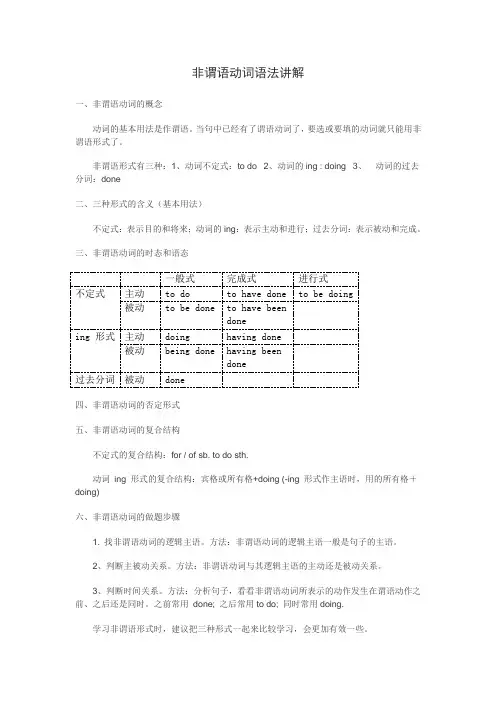
非谓语动词语法讲解一、非谓语动词的概念动词的基本用法是作谓语。
当句中已经有了谓语动词了,要选或要填的动词就只能用非谓语形式了。
非谓语形式有三种:1、动词不定式:to do 2、动词的ing : doing 3、动词的过去分词:done二、三种形式的含义(基本用法)不定式:表示目的和将来;动词的ing:表示主动和进行;过去分词:表示被动和完成。
三、非谓语动词的时态和语态一般式完成式进行式不定式主动to do to have done to be doing被动to be done to have beendoneing 形式主动doing having done被动being done having beendone过去分词被动done四、非谓语动词的否定形式五、非谓语动词的复合结构不定式的复合结构:for / of sb. to do sth.动词ing 形式的复合结构:宾格或所有格+doing (-ing 形式作主语时,用的所有格+doing)六、非谓语动词的做题步骤1. 找非谓语动词的逻辑主语。
方法:非谓语动词的逻辑主语一般是句子的主语。
2、判断主被动关系。
方法:非谓语动词与其逻辑主语的主动还是被动关系。
3、判断时间关系。
方法:分析句子,看看非谓语动词所表示的动作发生在谓语动作之前、之后还是同时。
之前常用done; 之后常用to do; 同时常用doing.学习非谓语形式时,建议把三种形式一起来比较学习,会更加有效一些。
一、非谓语动词作主语和表语的比较1、不定式和动名词作主语和表语a. 不定式表示一次性的、具体的动词。
动词ing 常表示一般的、泛指的或习惯性的动作。
如:________ is a good form of exercise for both young and old.A. The walkB. WalkingC. To walkD. Walk(分析) a good form 暗示泛指一般的行为,用动名词作主语,选 Bb. 不定式作主语时,常用it 作形式主语,即用句型:It is + adj. / n. + (for / of sb. ) to do sth.It’s important for us to learn English well.It’s kind of you to help us.注意:下面几个句型是用动名词:It’s no good / use doing sth.It’s useless doing sth.2、不定式、动名词、分词作表语的比较1、不定式、动名词作表语,.表示主语的内容。


(完整版)动词的非谓语动词形式讲解动词的非谓语动词形式讲解(完整版)非谓语动词指的是不具备人称和数的特征,不能独立做谓语,而需要与其他词语搭配使用的动词形式。
中文的非谓语动词形式主要有动词不定式、动名词和分词。
以下是对这三种非谓语动词形式的详细讲解:1. 动词不定式(Infinitive)动词不定式是表示动作或状态的一种形式,一般由动词原形前加上"to"构成。
动词不定式在句中可以担任主语、宾语、表语、定语、状语等成分。
示例:- 主语:To travel is my dream.(旅行是我的梦想。
)To travel is my dream.(旅行是我的梦想。
)- 宾语:I want to learn Chinese.(我想学中文。
)to learn Chinese.(我想学中文。
)- 表语:His hobby is to play the piano.(他的爱好是弹钢琴。
)to play the piano.(他的爱好是弹钢琴。
)- 定语:She needs a place to live.(她需要一个住的地方。
)to live.(她需要一个住的地方。
)- 状语:I went there to see the exhibition.(我去那里看展览。
)to see the exhibition.(我去那里看展览。
)2. 动名词(Gerund)动名词是动词的一种形式,以-ing结尾表示动作或状态,相当于名词,可以作为主语、宾语、表语、定语、状语等成分。
示例:- 主语:Swimming is good for health.(游泳对健康有益。
)Swimming is good for health.(游泳对健康有益。
)- 宾语:He enjoys reading books.(他喜欢读书。
)reading books.(他喜欢读书。
)- 表语:His favorite activity is singing.(他最喜欢的活动是唱歌。
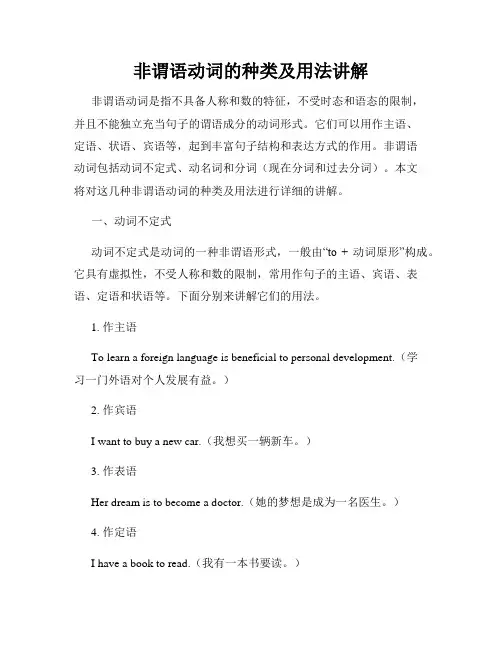
非谓语动词的种类及用法讲解非谓语动词是指不具备人称和数的特征,不受时态和语态的限制,并且不能独立充当句子的谓语成分的动词形式。
它们可以用作主语、定语、状语、宾语等,起到丰富句子结构和表达方式的作用。
非谓语动词包括动词不定式、动名词和分词(现在分词和过去分词)。
本文将对这几种非谓语动词的种类及用法进行详细的讲解。
一、动词不定式动词不定式是动词的一种非谓语形式,一般由“to + 动词原形”构成。
它具有虚拟性,不受人称和数的限制,常用作句子的主语、宾语、表语、定语和状语等。
下面分别来讲解它们的用法。
1. 作主语To learn a foreign language is beneficial to personal development.(学习一门外语对个人发展有益。
)2. 作宾语I want to buy a new car.(我想买一辆新车。
)3. 作表语Her dream is to become a doctor.(她的梦想是成为一名医生。
)4. 作定语I have a book to read.(我有一本书要读。
)5. 作状语He went to the library to study.(他去图书馆学习。
)二、动名词动名词是动词的一种非谓语形式,一般由动词的-ing形式构成。
它可以作主语、宾语、表语、定语和状语等,但不能用作动词的宾补。
下面逐一介绍它们的用法。
1. 作主语Swimming is good exercise.(游泳是一项好运动。
)2. 作宾语I enjoy reading novels.(我喜欢读小说。
)3. 作表语His hobby is playing basketball.(他的爱好是打篮球。
)4. 作定语She bought a running shoe.(她买了一双跑步鞋。
)5. 作状语He broke his leg while skiing.(他在滑雪时摔断了腿。
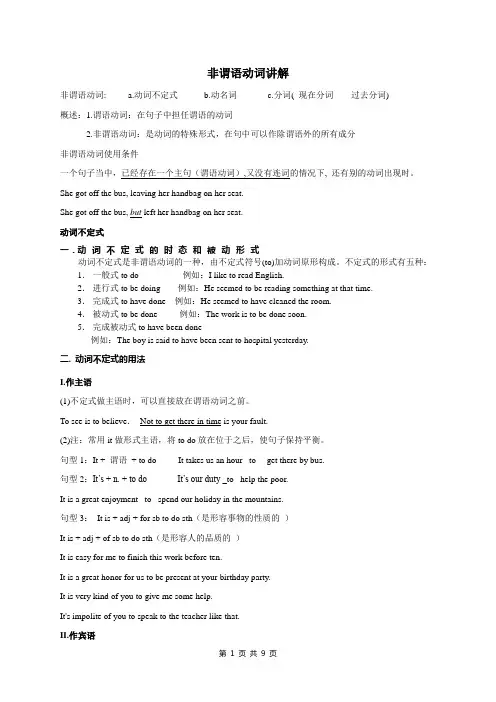
非谓语动词讲解非谓语动词: a.动词不定式 b.动名词 c.分词( 现在分词过去分词)概述:1.谓语动词:在句子中担任谓语的动词2.非谓语动词:是动词的特殊形式,在句中可以作除谓语外的所有成分非谓语动词使用条件一个句子当中,已经存在一个主句(谓语动词),又没有连词的情况下, 还有别的动词出现时。
She got off the bus, leaving her handbag on her seat.She got off the bus, but left her handbag on her seat.动词不定式一.动词不定式的时态和被动形式动词不定式是非谓语动词的一种,由不定式符号(to)加动词原形构成。
不定式的形式有五种:1.一般式to do 例如:I like to read English.2.进行式to be doing 例如:He seemed to be reading something at that time.3.完成式to have done 例如:He seemed to have cleaned the room.4.被动式to be done 例如:The work is to be done soon.5.完成被动式to have been done例如:The boy is said to have been sent to hospital yesterday.二. 动词不定式的用法I.作主语(1)不定式做主语时,可以直接放在谓语动词之前。
To see is to believe.Not to get there in time is your fault.(2)注:常用it做形式主语,将to do放在位于之后,使句子保持平衡。
句型1:It + 谓语+ to do It takes us an hour _to__ get there by bus.句型2:It’s + n. + to do It’s our duty _to_ help the poor.It is a great enjoyment _to_ spend our holiday in the mountains.句型3:It is + adj + for sb to do sth(是形容事物的性质的)It is + adj + of sb to do sth(是形容人的品质的)It is easy for me to finish this work before ten.It is a great honor for us to be present at your birthday party.It is very kind of you to give me some help.It's impolite of you to speak to the teacher like that.II.作宾语接不定式做宾语I want to know this matter.I don’t expect to meet you here(1)常见动词有:like, demand, expect, promise, begin, determine, refuse, offer, fail, manage, learn, seem,intend, forget, want, prepare, pretend, refuse, plan, afford, wish等They wanted _to get___( get ) on the bus, didn’t they? He said he wished __to be____( be ) a professor.(2)it作形式宾语I find/feel to work with him interesting .I find/feel it interesting to work with him.Subject+ find/think/feel/make/ consider… it+adj/n + to do sth.1.We thought _it__ better __to_ start early.2.Do you consider _it__ better not _to_ go?3. I feel _it_ my duty _to_ change all that.4.We think it __ important _ to _ obey the law.5.I know _ it _ impossible _ to _ finish so much homework in a day.(3)常跟疑问词+不定式作宾语的动词:tell, advise, show, teach, find out, decide, discuss, learn, explain, know, discover,He taught us how to use the tool. No one could tell me where to get the book.I haven't decided whether to go or stay.下列词接动名词和不定式均可,但意义不同的动词:stop to do 停下来去做stop doing 停止做forget to do 忘记要做forget doing 忘记做过remember to do 记得要做remember doing 记得做过regret to do 遗憾要做regret doing 后悔做过try to do 企图做,尽力做try doing 试着做go on to do 继续做(另一件事)go on doing 继续做(同一件事)mean to do 打算做mean doing 意味做In some parts of London, missing a bus means _A______ for another hour.A waitingB to waitingC waitD to be waitingBoys, don't forget _D____ the windows before you leave the classroom.A. closingB. closedC. to closingD. to closeShe reached the top of the hill and stopped __C_____ on a big rock.A. to have restedB. restingC. to restD. restRemember _A______ the lights when you leave the office.A. to turn offB. turning offC. turn offD. to turning off(4)在cannot but, cannot choose/help but 之后接不带to的不定式I have no choice but __to wait_____.(wait)“前有do,后无to”I can’t do anything but _go______ (go )out with her.III.作宾语补足语1. I’ll get someone _to__ repair the recorder for you.2. What caused him _to__ change his mind?advise, allow, ask, beg, cause, expect, encourage, force, get, hate, invite , order, wish , want, warn, remind, promise, permit, persuade, request+sb. to do注意:(1)在动词feel (一感),hear, listen to(二听),have, let, make(三让),notice, see, watch, observe, look at(五看)(即:吾看三室两厅一感觉)等后面的补足语中,不定式不带to,但变为被动语态后,必须带to。
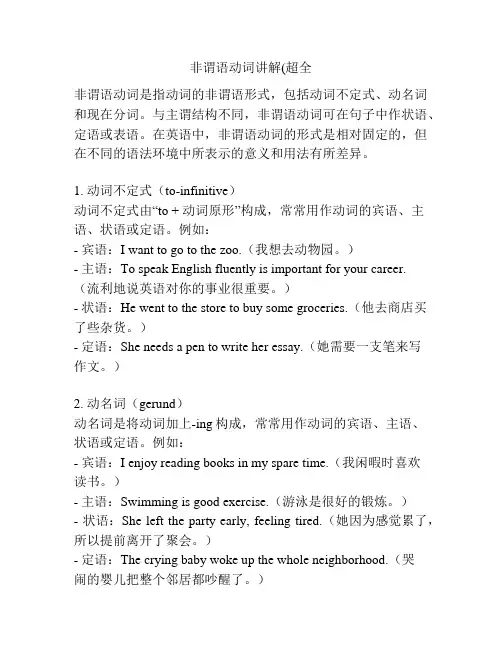
非谓语动词讲解(超全非谓语动词是指动词的非谓语形式,包括动词不定式、动名词和现在分词。
与主谓结构不同,非谓语动词可在句子中作状语、定语或表语。
在英语中,非谓语动词的形式是相对固定的,但在不同的语法环境中所表示的意义和用法有所差异。
1. 动词不定式(to-infinitive)动词不定式由“to + 动词原形”构成,常常用作动词的宾语、主语、状语或定语。
例如:- 宾语:I want to go to the zoo.(我想去动物园。
)- 主语:To speak English fluently is important for your career.(流利地说英语对你的事业很重要。
)- 状语:He went to the store to buy some groceries.(他去商店买了些杂货。
)- 定语:She needs a pen to write her essay.(她需要一支笔来写作文。
)2. 动名词(gerund)动名词是将动词加上-ing构成,常常用作动词的宾语、主语、状语或定语。
例如:- 宾语:I enjoy reading books in my spare time.(我闲暇时喜欢读书。
)- 主语:Swimming is good exercise.(游泳是很好的锻炼。
)- 状语:She left the party early, feeling tired.(她因为感觉累了,所以提前离开了聚会。
)- 定语:The crying baby woke up the whole neighborhood.(哭闹的婴儿把整个邻居都吵醒了。
)3. 现在分词(present participle)现在分词由动词原形加上-ing构成,常常用作动词的宾语、主语、状语或定语。
例如:- 宾语:He enjoys playing soccer on weekends.(他喜欢周末踢足球。
)- 主语:Listening to music helps me relax.(听音乐帮助我放松。
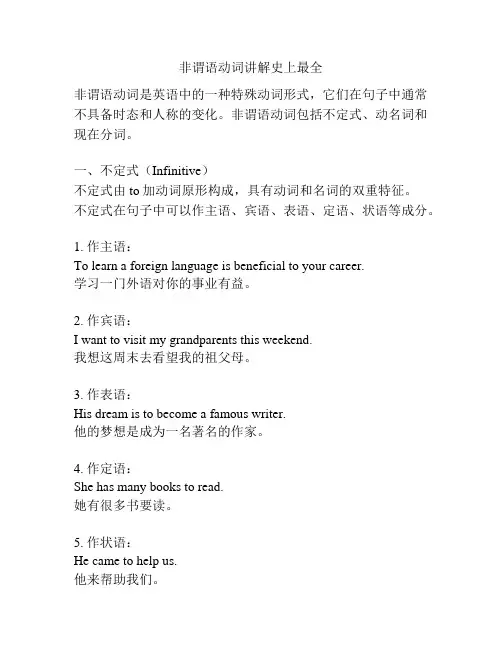
非谓语动词讲解史上最全非谓语动词是英语中的一种特殊动词形式,它们在句子中通常不具备时态和人称的变化。
非谓语动词包括不定式、动名词和现在分词。
一、不定式(Infinitive)不定式由to加动词原形构成,具有动词和名词的双重特征。
不定式在句子中可以作主语、宾语、表语、定语、状语等成分。
1. 作主语:To learn a foreign language is beneficial to your career.学习一门外语对你的事业有益。
2. 作宾语:I want to visit my grandparents this weekend.我想这周末去看望我的祖父母。
3. 作表语:His dream is to become a famous writer.他的梦想是成为一名著名的作家。
4. 作定语:She has many books to read.她有很多书要读。
5. 作状语:He came to help us.他来帮助我们。
二、动名词(Gerund)动名词由动词原形加-ing构成,具有动词和名词的双重特征。
动名词在句子中可以充当主语、宾语、表语、定语、状语等成分。
1. 作主语:Swimming is my favorite sport.游泳是我最喜欢的运动。
2. 作宾语:I enjoy reading novels in my free time.我喜欢在空闲时间读小说。
3. 作表语:Her hobby is singing.她的爱好是唱歌。
4. 作定语:The running water is clear.流动的水很清澈。
5. 作状语:She went shopping after finishing her homework.她在完成作业后去购物。
三、现在分词(Present Participle)现在分词由动词原形加-ing构成,具有动词和形容词的双重特征。
现在分词在句子中可以充当定语、表语、状语等成分。
非谓语动词讲解以及例句非谓语动词是指动词的非谓语形式,不受主语的人称和数的限制,常用作句子的宾语、定语或状语。
非谓语动词包括动名词、不定式和分词三种形式。
一、动名词(-ing形式):1. 作主语:Being kind to others is always a good thing to do.(对他人友善总是值得做的好事。
)2. 作宾语:I enjoy swimming in the ocean.(我喜欢在海里游泳。
)3. 作宾补:She made a decision, ending their relationship.(她做出了一个决定,结束了他们的关系。
)4. 作定语:The running water is so clear and refreshing.(流动的水非常清澈和令人神清气爽。
)5. 作状语:Knowing the answer, he raised his hand.(知道答案后,他举手了。
)二、不定式(to + 动词原形):1. 作主语:To learn a new language is challenging but rewarding.(学习一门新语言是具有挑战性但值得的。
)2. 作宾语:She wants to visit Paris next year.(她想明年去巴黎旅游。
)3. 作宾补:I need to finish this report by tomorrow.(我需要明天之前完成这份报告。
)4. 作定语:He is the best person to ask for help.(他是寻求帮助的最佳人选。
)5. 作状语:She went to the library to study.(她去图书馆学习。
)三、分词:1. 现在分词(-ing形式):The crying baby woke up the entire neighborhood.(哭闹的婴儿吵醒了整个社区。
非谓语动词讲解非谓语动词是指在句子中充当动词的成分,但没有明确的时态和主语,通常用来修饰主语或者作宾语补足语。
常见的非谓语动词包括动词不定式、动名词和分词(包括现在分词和过去分词)。
下面将对这三种非谓语动词进行详细讲解。
1. 动词不定式(Infinitive)动词不定式由“to + 动词原形”构成。
它可用作主语、宾语、定语、状语或表语等。
动词不定式常用于表示目的、原因、结果、意愿、允许、能力、习惯等。
例如:- To learn a foreign language is interesting.(不定式作主语)- I want to travel around the world.(不定式作目的状语)- She is old enough to take care of herself.(不定式作定语)- He went to the supermarket to buy some groceries.(不定式作目的状语)2. 动名词(Gerund)动名词是动词的现在分词形式,具有动词和名词的双重性质。
它可以作主语、宾语、定语、状语或表语等。
动名词常用于表示动作、经验、兴趣、喜好等。
例如:- Running is good exercise.(动名词作主语)- I enjoy playing chess.(动名词作宾语)- The painting hanging on the wall is my favorite.(动名词作定语)- She entered the room, smiling.(动名词作表语)3. 分词(Participle)分词是由动词的-ing形式或-ed形式构成的形容词,用来修饰名词或代词。
现在分词通常表示主动,过去分词通常表示被动。
例如:- The running water is very clear.(现在分词作定语)- I saw a broken window in the house.(过去分词作定语)- The excited children couldn't sit still.(现在分词作定语)- The stolen wallet was reported to the police.(过去分词作定语)需要注意的是,非谓语动词在句子中可能需要根据上下文的具体要求,变换为不同的形式,也可能需要加上适当的助动词或情态动词。
非谓语动词t h e N o n-F i n i t e V e r b s 定义在句子中不是谓语的动词,形式:不定式、动名词和分词现在分词和过去分词作用:在句子中充当主语、宾语、状语等.特点:1.非谓语动词可以有名词作用如动词不定式和动名词,在句中做主语、宾语、表语.2.非谓语动词可以有形容词作用如动词不定式和分词,在句中做定语、表语或宾语补足语.3.非谓语动词可以有副词作用如动词不定式和分词,在句中作状语.4.谓语动词在句中作谓语,受主语的人称和数的限制;非谓语动词在句中不能单独作谓语,它不受主语的人称和数的限制.5.英语中不能单独做句子的谓语.与谓语动词的关系相同点(1)如果是及物动词都可与宾语连用,例如: They built a garden. They suggested building a garden.(2)都可以被状语修饰: The suit fits him very well. The suit used to fit him very well.(3)都有主动与被动, “体”式一般式;进行式;完成式的变化.例如:He was punished by his parents.谓语动词被动语态 He avoided being punished by his parents.动名词的被动式We have written the composition.谓语动词的完成时 Having written the composition, we handed it in.现在分词的完成式(4)都可以有逻辑主语They started the work at once.谓语动词的逻辑主语 The boss ordered them to start the work.动词不定式的逻辑主语We are League members.谓语动词的主语 We being League member, the work was well done. 现在分词的逻辑主语不定式一、形式功能:动词不定式:to+do,具有名词、形容词、副词的特征.否定式:not + to do 以do为例,动词不定式的构成如下:(1)一般式:不定式的一般式所表示的动作与谓语动词动作同时发生或发生在谓语动词动作之后.例如: I'm nice to meet you. 很高兴见到你.He seems to know a lot. 他看起来懂得很多.We plan to pay a visit. 我们计划花钱去参观.He wants to be an artist. 他想成为一个艺术家.The patient asked to be operated on at once. 病人要求马上手术.The teacher ordered the work to be done. 老师要求完成工作.(2)进行式:不定式的进行式所表示的动作与谓语动词动作同时发生,例如:The boy pretended to be working hard. 男孩假装工作得很努力.He seems to be reading in his room. 看起来他正在他的房间里面读书.3完成式:不定式的完成式表示的动作发生在谓语动词动作之前,例如:I regretted having told a lie. 我后悔我说谎了.I happened to have seen the film. 我偶然看过这部电影.He is pleased to have met his friend. 他很高兴能遇上他的朋友.二、不定式的句法功能:(1)作主语:To finish the work in ten minutes is very hard. 十分钟之内完成这项工作是很难的.To lose your heart means failure. 灰心意味着失败.动词不定式短语作主语时,常用it作形式主语,真正的主语不定式置于句后,例如上面两句可用如下形式:It is very hard to finish the work in ten minutes. 十分钟之内完成这项工作是很难的.It means failure to lose your heart. 灰心意味着失败.常用句式有:1作主语:1、It+be+名词+to do.2、It takes sb.+some time+to do.3、It+be+形容词+of sb +to do.①与careless,clever,good,foolish,honest,kind,lazy,nice,right,silly,stupid,wis e,wrong , careful , polite , 等表示赞扬或批评的形容词连用,不定式前的sb.可作其逻辑主语.②与for连用的通常是一些表示可能性、难易程度、必要性等含义的形容词:possible,impossible,easy,hard,difficult,necessaryIt’s necessary for you to study hard .necessary 修饰 to study hard,表示学习努力是有必要的It’s foolish of him to do it .foolish 修饰逻辑主语him2作表语:放be动词后,构成表语Her job is to clean the hall. 她的工作是打扫大厅.He appears to have caught a cold. 他似乎感冒了.注意:(3)作宾语:①动词+不定式.如:He managed to escape from the fire.I find it hard to get along with him.it 作形式宾语下列动词通常用不定式作宾语:want, hope, wish, offer, fail, plan, learn, pretend, refuse, manage, help, promise, prefer, like , begin , try , need , forget , agree , know , teach , help , arrange , dare , decide , determine , prepare , continue , ask , mean , choose , expect ,choose, get等②动词+疑问词+to , “特殊疑问句+不定式”相当于名词,作宾语.如:I don’t know what to do next/ how to do it next.I can’t decide when to go there.注意:不定式短语作宾语时,如果还带有宾语补足语,往往把不定式短语放在宾语补足语之后,用it 作形式宾语.如:I find it necessary to learn a foreign language.We think it important to obey the laws .不定式动词可充当介词宾语,如:I have no choice but to stay here. 我只能留在这里,别无选择.He did nothing last Sunday but repair his bike. 他上周日除了修他的自行车什么也没干.Marx found it important to study the situation in Russia. 马克思发现研究俄国的情况是很重要的.(4)作宾语补足语:①动词+宾语+不定式to doHe warned me to be careful.I want you to speak to Tom.What makes you think so不带to的不定式注:可以用动词不定式做宾补的动词有:ask, tell, order ,want ,get, would like, like, advise, invite, allow, help, wish,warn, expect, prefer, encourage,beg, permit, persuade,prepare, cause, force, call on, wait for, invite.此外,介词有时也与这种复合宾语连用,如:With a lot of work to do, he didn't go to the cinema.他有很多工作要做,所以没去电影院.②表见解、看法的动词结构可为:动词+宾语+ to be 的不定式结构:We consider Tom to be one of the best students in our class.The book is believed to be useful.被动语态③ There +不定式We didn’t expect there to be so many people there.我们没料到会有那么多人在那里.注意:1有些动词需用 as 短语作补语,像regard, think, believe, take, consider.如:We regard Tom as our best teacher. 我们认为汤姆是我们最好的老师.Mary took him as her father. 玛丽把他当作自己的父亲.2在动词feel 一感,hear, listen to二听,have, let, make三让,notice, see, watch, observe, look at五看即:吾看三室两厅一感觉等后面的补足语中,不定式不带to,但变为被动语态后,必须带to.如:They saw the boy fall off the tree. The boy was seen to fall off the tree.3help后面作宾语补足语的不定式可以带to,也可以不带to.I often help him toclean the room.(5)作定语:动词不定式作定语,放在所修饰的名词或代词后.与所修饰名词有如下关系:1)He is looking for a room to live in.动状关系He has got a chance to go abroad.同位关系3主谓关系:She is always the last person to speak at the meeting . ----I’mgoing to the post office , for I have a letter to post .逻辑主语是I -------Thank you. But I have no letters to be posted now 逻辑主语不是I4动宾关系:I have a meeting to attend. 我有一个会议要出席.注意:如果作定语的不定式是一个短语,则要保留不定式短语中的副词或介词.如:I need a pen to write with . I will wirte with the pen 我需要一直钢笔写字I have a little baby to look after .I must look after the little baby 我有一个婴儿要照看He is looking for a room to live He is looking for a room to live in .What did you open it with 你用什么打开它如果不定式修饰time, place, way,可以省略介词:He has no place to live. 他无处安身.This is the best way to work out this problem. 这是解决这个问题的最好办法.He has no money and no place to live in .I think the best way to travel by is on foot .There is no time to think about .注意:①不定式的逻辑主语是句子的主语时,不定式用主动形式表被动、也可用被动式:Have you got anything to send 你要送什么东西吗 Have you got anything to be sent 你有什么东西需要送吗②说明所修饰名词的内容: We have made a plan to finish the work. 我们制定了一个完成工作的计划.③被修饰名词是不定式逻辑主语: He is the first to get here. 他第一个来到这儿.6作状语:①表目的:He worked day and night to get the money. 他夜以继日地工作来赚钱.She sold her hair to buy the watch chain. 她卖掉了自己的头发来买那条表链.注意不定式放句首时,逻辑主语与句子主语要一致: wrong:To save money, every means has been tried. right:To save money, he has tried every means. 为了省钱,他使出了浑身解数. wrong:To learn English well, a dictionary is needed. right:To learn English well, he needs a dictionary. 为了学好英语,他需要一本词典.作目的状语:既可以放在句首,也可以放在句尾 To tell you the truth, I don't like the way he talked. 说实话,我不喜欢他讲话的方式.②表结果往往是与预期愿望相反的结果意料之外:常放在never only后He arrived late only to find the train had gone. 他来晚了,只见火车已经走了.I visited him only to find him out. 我去拜访他,只见他出去了.③表原因:常放在形容词后面They were very sad to hear the news. 他们听到这条新闻非常伤心.④表程度:It's too dark for us to see anything. 太暗了,我们什么也看不见.The question is simple for him to answer. 这问题由他来回答是很简单的.三、不定式的省略:①情态动词除ought外, ought to do②would rather, had better③感官动词和使役动词④由 and, or 和 than 连接的两个不定式,第二个 to 可以省去.如:He wants to move to France and marry the girl.⑤help⑥Why…/Why not…⑦But 和 except 前是动词 do 时,后面出现的动词用不带 to 的动词不定式.试比较:He wants to do nothing but go out.He wants to believe anything but to take the medicine.⑧通常在discover, imagine, suppose, think, understand 等词后,可以省去 to be .如:⑨保留to省略do动词. If you don't want to do it, you don't need to. 如果你不想做这件事,你就不必做.⑩不定式的并列:第二个不定式可省略to.下列短语中,如果意义明确,常常省略到to:want to , wish to ,hope to , like to , hate to , plan to , try to , love to , have to , ought to , need to , used to , be able toHe wished to study medicine and become a doctor. 他希望学医并成为医生.五、注意:1.to 作介词:agree to, object to,close to , come to , lead to , refer to , equal to , familiar to , point to , thank to , devote to , next to , belong to , be used to , look forward to动名词一、定义:动名词既具有动词的一些特征,又具有名词的句法功能.二、形式:一般式 doing 谓语动词同时发生 being done Seeing is believing. 眼见为实.完成式 having done having been done 谓语动词发生之前We remembered having seen the film. 我们记得看过这部电影.否定式:not + 动名词动名词的形式: I regret not following his advice. 我后悔没听他的劝告.被动式: He came to the party without being invited.他未被邀请就来到了晚会.完成被动式: He forgot having been taken to Guangzhou when he was five years old. 他忘记五岁时曾被带到广州去过.复合结构:物主代词或名词所有格+ 动名词He suggested our trying it once again. 他建议我们再试一次.His not knowing English troubled him a lot. 他不懂英语给他带来许多麻烦.三、动名词的句法功能:(1)作主语:谓语用单数Reading aloud is very helpful.Collecting stamps is interesting.Playing with fire is dangerous.当动名词短语作主语时常用it作形式主语.结构:It’s no good/use doing.... It's no use quarrelling.争吵是没用的.(2)作表语:动名词可以和主语调换位置.如:My hobby is collecting stamps.In the ant city, the queen's job is laying eggs. 在蚂蚁王国,蚁后的工作是产卵.3作宾语:They haven't finished building the dam. 他们还没有建好大坝.We have to prevent the air from being polluted. 我们必须阻止空气被污染.注意动名词既可作动词宾语也可作介词宾语,如上面两个例句.此外,动名词作宾语时,若跟有宾语补足语,则常用形式宾语it,例如: We found it no good making funof others. 我们发现取笑他人不好.只接V-ing做宾语的动词和动词短语:enjoy, finish, suggest, avoid, excuse ,delay, imagine, keep, miss, consider, admit,deny, mind, permit, forbid, practise, risk, appreciate, be busy, be worth, feel like, can't stand, can't help, think of, dream of, be fond of, prevent…from,keep …from, stop…from,protect…from, set about, be engag ed in, spend…in, succeed in, be used to, look forward to, object to, pay attention to, insist on, feel like接动名词、不定式均可,且意义相同的动词:like, love, dilike,hate, begin, star, continue, prefer, cease, can’t bear/endure/stand接动名词、不定式均可,但意义不同的词:forget,go on,mean,regret,remember,stop,try等Stop to do 停下来去做 stop doing 停止做Forget to do 忘记要做 forget doing 忘记做过Remember to do 记得要做 remember doing 记得做过Regret to do 遗憾要做 regret doing 后悔做过Try to do 企图做,尽力做 try doing 试着做Go on to do 继续做另一件事 go on doing 继续做同一件事Mean to do 打算做 mean doing 意味做注意:Need, require, want作“需要”讲,其后用动名词的主动式表示被动意义,be worth也有类似用法.如:The flowers need watering/to be watered.The problem is worth discussing.(4)作定语:动名词作定语,一般表示用途.如:a waiting room,a diving board,a reading room,a dining hall动名词与现在分词作定语的区别:1现在分词作定语表动作,它与所修饰的名词之间存在逻辑上的主谓关系,可改写成一个定语从句.如果为单词,放在被修饰n之前,为短语,放在被修饰n之后.如:a sleeping boy =a boy who is sleepinga developing country =a country which is developing2动名词作定语通常表示它所修饰的名词的用途或性质,可改写成一个for的短语,两者不存在逻辑上的主谓关系.如:a washing machine = a mashine for washinga swimming pool = a pool for swimmingHe can't walk without a walking-stick. 他没有拐杖不能走路.Is there a swimming pool in your school 你们学校有游泳池吗(5)作同位语: The cave, his hiding-place is secret. 那个山洞,他藏身的地方很秘密.His habit, listening to the news on the radio remains unchanged.他收听收音机新闻节目的习惯仍未改变.分词一、现在分词和过去分词的区别:1在语态上,现在分词表示主动意义;过去分词表示被动意义,不及物动词的过去分词表示动作已经发生.像:gone, fallen, retired, grown-up, escaped, faded, returned等词.如:a retired person 一个退休的人 a fallen ball 一个落下来的球2在时间上,现在分词表示的动作往往正在进行或者与谓语动词同时发生,过去分词表示的动作已经完成或没有一定的时间性.如:falling leaves 正在下落的树叶 fallen leaves 已经落在地上的树叶注意:分词作时间状语,如果先于主动词的动作,且强调先后,要用having done.如:Having finished his homework, he went out for a walk.=After he had finished his homework, he went out for a walk.二、注意:1分词作状语,其逻辑主语要与主句主语保持一致2分词前常有when / while / as / before/ after/ if / unless /even if 等引导词3如果过去分词的动作发生在主句谓语之前,用having been done Having been hurt in a traffic accident, I was given an operation.4分词做状语,主语之前不可有and /but / so / or/ so that 等连词如有,则此句子为祈使句Working hard, you will succeed.Working hard and you will succeed.5)否定式,在分词之前+ not6)固定搭配: be dressed in be lost in thoughts lost in thoughts, he knocked into me.7)分词的逻辑主语与主句不同,分词要有自己的逻辑主语,称为“独立主语” The money used up, I had no food to eat现在分词二、定义:既具有动词的一些特征,又具有形容词和副词的句法功能.二、形式:肯定式:V-ing;否定式:not + 现在分词(1)主动语态:现在分词主动语态的一般式表示与谓语动词所表示的动作同时发生,完成式表示的动作在谓语动词所表示的动作之前发生,常作状语.例如:They went to the park, singing and talking. 他们边唱边说向公园走去.Having done his homework, he played basket-ball. 做完作业,他开始打篮球.(2)被动语态:一般式表示与谓语动词同时发生的被动的动作,完成式表示发生在谓语动词之前的被动的动作.The problem being discussed is very important. 正在被讨论的问题很重要.Having been told many times, the naughty boy made the same mistake. 被告诉了好几遍,这个淘气的孩子又犯了同一个错误.三、现在分词的句法功能:(1)作定语:现在分词作定语,当分词单独做定语时,放在所修饰的名词前;如果是分词短语做定语放在名词后.In the following years he worked even harder. 在后来的几年中,他学习更努力了.The man speaking to the teacher is our monitor's father. 正与老师谈话的那个人是我们班长的父亲.现在分词作定语相当于一个定语从句的句法功能,如:in the following years也可用in the years that followed; the man speaking to the teacher可改为the man who is speaking to the teacher.(2)现在分词作表语: The film being shown in the cinema is exciting. 正在这家上演的电影很棒.The present situation is inspiring. 当前的形势鼓舞人心.be + doing既可能表示现在进行时,也可能是现在分词做表语,它们的区别在于be + doing表示进行的动作是进行时,而表示特征时是系动词be与现在分词构成系表结构.3作宾语补足语:如下动词后可跟现在分词作宾语补足语:see, watch, hear, feel, find, get, keep, notice, observe, listen to, look at, leave, catch等.例如:Can you hear her singing the song in the next room 你能听见她在隔壁唱歌吗He kept the car waiting at the gate. 他让小汽车在门口等着. (4)现在分词作状语:①作时间状语: While Working in the factory, he was an advanced worker. 在工厂工作时,他是一名先进工人.②作原因状语: Being a League member, he is always helping others. 由于是共青团员,他经常帮助他人.③作方式状语,表示伴随: He stayed at home, cleaning and washing. 他呆在家里,又擦又洗.④作条件状语: If Playing all day, you will waste your valuable time. 要是整天玩,你就会浪费宝贵的时间.⑤作结果状语: He dropped the glass, breaking it into pieces. 他把杯子掉了,结果摔得粉碎.⑥作目的状语: He went swimming the other day. 几天前他去游泳了.⑦作让步状语: Though raining heavily, it cleared up very soon. 虽然雨下得很大,但不久天就晴了.⑧与逻辑主语构成独立主格:I waiting for the bus, a bird fell on my head.All the tickets having been sold out, they went away disappointedly. 所有的票已经卖光了,他们失望地离开了.Time permitting, we'll do another two exercises. 如果时间允许,我们将做另两个练习.有时也可用with without +名词代词宾格+分词形式 With the lights burning,he fell asleep. 他点着灯睡着了.⑨作独立成分: udging fromby his appearance, he must be an actor. 从外表看,他一定是个演员. Generally speaking, girls are more careful. 一般说来,女孩子更细心.过去分词一、形式:只有V-ed一种形式.①规则,V-ed, ②不规则二、句法功能1.过去分词作定语:①单个过去分词做定语时用于被修饰的名词前,做前置定语 frozen food、polluted river、a terrified boyVt.过去分词作定语,表被动及完成Vi 过去分词作定语,表示完成 a married man an escape man the risen sun a fallen leafOur class went on an organized trip last Monday. 上周一我们班开展了一次有组织的旅行.Those selected as committee members will attend the meeting. 当选为委员的人将出席这次会.②凡是用作定语修饰人或表示与个人相关的心理状态,用过去分词,而修饰物时,则用现在分词做定语a satisfied smile a satisfying answerTom tired at the tiring speech,started to sleep.③过去分词短语做定语时,用于被修饰的名词之后,相当于省略了which/who is/are:A book written by luxun a student called MaryThe meeting being held now is important.The meeting held yesterday was importantThe meeting to be held tomorrow is important.2.过去分词作表语: The window is broken. 窗户破了.They were frightened at the sad sight. 他们对眼前悲惨的景象感到很害怕.注意:be + 过去分词,如果表示状态是系表结构,如果表示被动的动作是被动语态.区别: The window is broken.系表 The window was broken by the boy.被动有些过去分词是不及物动词构成的,不表示被动,只表示完成.如:boiled water开水 fallen leaves落叶newly arrived goods新到的货 the risen sun升起的太阳 the changed world 变了的世界这类过去分词有:gone, come, fallen, risen, changed, arrived, returned, passed等.3.过去分词作宾语补足语:①做宾语补足语的动词一般是Vt,表示被动或完成With+sth./sb. DoneWith the work done, they went out to play. 工作做完了,他们出去玩去了.With trees planted around the school, it looks nicer.②Have /get + sb/sth. Done 叫人做....Make oneself kmow/ understood/ hearted 让自己被....③see /hear/ watch / notice/ observe / listen to等构成的感官动词及 think/ find 等表示心理状态的动词 ~ sth/ sb. done1)I hear this song sung2)I found the dooe unlocked when I got home.④ want / wish / like / expect / order sth /sb. Done 希望、命令......被做I want the problem discussed at the meeting.4.过去分词作状语:Praised by the neighbours, he became the pride of his parents. 受到邻居们的表扬,他成为父母的骄傲.原因Once seen, it can never be forgotten. 一旦它被看见,人们就忘不了.时间Given more time, I'll be able to do it better. 如果给予更多的时间,我能做得更好.条件Though told of the danger, he s till risked his life to save the boy. 虽然被告之有危险,他仍然冒生命危险去救那个孩子.让步Filled with hopes and fears, he entered the cave. 心中充满了希望与恐惧,他走进山洞. 方式/伴随。
非谓语动词非谓语动词与谓语动词(概念及含义)1.非谓语动词和谓语动词都是动词的某种形式在句子中做某种成分。
2.谓语动词在句中可单独作谓语,而非谓语动词不能单独作谓语。
3.一个简单句里只能有一个谓语动词,非谓语没有此限制。
4.谓语动词受主语的人称和数的限制(主谓一致),而非谓语动词形式没有这种限制。
非谓语的形式非谓语动词包含四种形式,即动名词、现在分词、过去分词和不定式。
其中,每种形式按照发生时间和主被动又包括不同的子形式。
一.非谓语动词在句子中的成分----7个1.动名词和动词不定式做主语动名词:Getting up early is a good habit.早起是一个好习惯。
动词不定式:To get up early is important for tomorrow’s test.早起对于明天的考试很重要。
2.动名词和动词不定式做宾语动名词:I like eating noodles. 我喜欢吃面条。
动词不定式:I like to eat noodles. 我喜欢吃面条。
3.动名词和动词不定式做同位语动名词:I got a job reading books for kids.我找到了一份工作,给小孩儿念书(听)。
Luckily Mr. Mandela remembered me and gave me a job taking tourists around myold prison on Robben island. 很幸运,曼德拉先生还记得我,并且给了我一份工作,带领游客参观我在罗德岛的监狱动词不定式:He got a chance to compete in the Olympics他得到了机会,去参加奥运会。
He has a wish to travel round the whole country.他有一个愿望,要去环游全国。
3.四种非谓语动词做表语1)动名词和动词不定式做表语动名词:My work is cleaning the yard every day. 我的工作是每天打扫院子。
非谓语动词讲解超全非谓语动词是指不具有人称和数的动词形式,不需要依附主语就可以使用的动词形式。
非谓语动词包括动词不定式、动名词和现在分词等形式。
非谓语动词的使用可以丰富句子结构,增强表达效果,表达出动作的进行、完成、目的、原因等不同的语义关系。
一、动词不定式动词不定式是动词的一种非谓语形式,由“to” + 原形动词构成,具有名词、形容词或副词的特性。
1. 作主语:To learn English well is my goal.(学好英语是我的目标。
)2. 作宾语:I want to take a nap.(我想睡个觉。
)3. 作宾补:She found it difficult to solve the math problem.(她发现解决这个数学问题很困难。
)4. 作表语:My dream is to become a teacher.(我的梦想是成为一名教师。
)5. 作状语:He left the room to make a phone call.(他离开房间去打电话。
)二、动名词动名词是动词的一种非谓语形式,多用于表示动作的稳定状态或被动的形式,常常作主语、宾语或介词的宾语。
1. 作主语:Swimming is my favorite sport.(游泳是我最喜欢的运动。
)2. 作宾语:I enjoy reading books.(我喜欢阅读书籍。
)3. 作宾补:He kept silent, not wanting to reveal the secret.(他保持沉默,不想泄露秘密。
)4. 作介词的宾语:She is good at playing the piano.(她擅长弹钢琴。
)三、现在分词现在分词是动词的一种非谓语形式,通常以-ing结尾,可以表示主动、进行、伴随等含义。
1. 作定语:The running dog scared the child.(奔跑的狗吓唬了孩子。
非谓语动词语法讲解一、非谓语动词的概念动词的基本用法是作谓语。
当句中已经有了谓语动词了,要选或要填的动词就只能用非谓语形式了。
非谓语形式有三种:1、动词不定式:to do 2、动词的ing : doing 3、动词的过去分词:done★不定式:表示目的和将来;动词的ing:表示主动和进行;过去分词:表示被动和完成。
二、非谓语动词的时态和语态一般式完成式进行式不定式主动to do to have done to be doing被动to be done to have been doneing 形式主动doing having done被动being done having been done过去分词被动done三.非谓语动词的句法功能:(一)动词不定式:to+do1.不定式的否定式:not + to do(1)一般式:不定式的一般式所表示的动作与谓语动词动作同时发生I'm glad to meet you.He seems to know a lot.(2)进行式:不定式的动作正在发生The boy pretended to be working hard.He seems to be reading in his room.(3)完成式:不定式的完成式表示的动作发生在谓语动词动作之前I regretted to have told a lie.I happened to have seen the film.2.不定式的句法功能:(1)作主语:To finish the work in ten minutes is very hard.★动词不定式短语作主语时,常用it作形式主语,真正的主语不定式置于句后It is very hard to finish the work in ten minutes.It means failure to lose your heart.(2)作表语:Her job is to clean the hall.He appears to have caught a cold.(3)作宾语:常与不定式做宾语连用的动词有:want, hope, wish, offer, fail, plan, learn, pretend, refuse, manage, help, agree, promise, prefer。
非谓语动词【真题再现】1. —Some children can't afford ________ necessary stationary. (2014 扬州)—Let's donate our pocket money to them.A. buyB. buyingC. to buyD. be bought2. My parents always tell me ________ more vegetables and fruit. (2014 北京)A. eatB. eatingC. eatsD. to eat3. Spring Bud Project is an organization that raises money ________ poor young girls return to school. (2014 镇江)A. to saveB. savingC. helpingD. to help4. Granny often tells us ________ water in our daily life.(2014 泰安)A. saveB. savingC. to saveD. saves5. Tom’s mother told him ________ eating too much meat.(2014黔西南州)A. stoppingB. to stopC. stopsD. stopped6. —Hey guys, Chinese way of ________ the road is verydangerous. You must wait for the green lights on. (2014 昆明)— Thank you for your advice, sir.A. goingB. walkingC. crossingD. passing7. —What else should we pay attention to ________ building the bridge?(2014 淮安)-The change of the weather, I think.A. finishB. finishedC. to finishD. finishing8. —Tom, why are you in such a hurry?(2014黑龙江省龙东地区)-Oh, my bike is broken, I’m going to have it ________.A. repairingB. repairedC. to repair9. The WWF is working hard __________ the animals in danger.(2015 南宁)A.save B.to save C.saves D.saved10. Sarah, you’d better drink more water after __________ for sucha long time. (2015 广州)A. runB. runsC. to runD. running11. This sign is used ________ tourists to stay away from the lion in the zoo.(2015 南通)A.to warn B.to warning C.to make D.to making12. Thanks to the robots, the human reporters do not have to spend alot of time _______ boring numbers and information.(2015 临沂) A.processing B.to process C.processedD.process13. My friend invited me __________ the art club, and I accepted it with pleasure.(2015 上海)A. joinB. to joinC. joinedD. joining14. Martin was so busy __________the old that he gave up his part-time job.(2015 上海)A. helpingB. helpedC. to helpD. help15.The traffic signs warn people after drinking. (2015 青岛)A. to driveB. not to driveC. drivingD. don’t drive【用法讲解】考试要求:非谓语动词中考考查的重点有:1. it 作形式主语、宾语的用法;2. 感官动词后不定式作宾语补足语和动词-ing形式作宾语补足语的用法;3. 动词不定式与疑问代词和疑问副词的连用;4. 一些特殊动词的动词不定式作宾语补足语时不带to,但变为被动语态时就要带to;5. 有些动词既可以接不定式也可以接动词-ing形式作宾语,但是表达的意思不同。
1. 动词不定式(1)动词不定式的构成:不定式的基本形式为:to+动词原形,有时可以不用to,这里的to是不定式符号,本身无词义,动词不定式的否定形式是not+(to+)动词原形。
(2)动词不定式的句法功能:1)不定式作主语动词不定式作主语时,常用it作形式主语,而将真正的主语放在句末,其结构为:It + be + adj. +(for/of sb.)+动词不定式。
如:To learn English well is useful.→It is useful to learn English well.学好英语很有用。
It’s important for us to protect the environment.保护环境对我们来说很重要。
注意:在kind,good,nice,clever等表示人的品质的形容词后,不用for而用of。
如:It’s very kind of you to help me.你帮助我真是太好啦。
It’s very clever of you to do like that.你那样做真是太聪明啦!2)不定式作宾语①一些谓语动词后只能用不定式作宾语,常见的这类词是表示命令、打算或希望的,如:would like,like,want,wish,hope,decide,plan,expect等。
如:Would you like to see a film this evening?你今晚想去看电影吗?②在find,think后跟不定式作宾语时,常用it代替,而将真正的宾语放在句末。
如:I find it easy to read English every day.我发现每天读英语很容易。
③常见的一些不带to的动词不定式why not do...,why don’t you do...,had better(not) do...,would rather do,could/would/will you please(not) do...如:I would rather stay in the room.我宁愿待在房间里。
3)不定式作宾语补足语不定式作宾语补足语时与宾语有逻辑上的主谓关系。
如:tell,ask,want,allow,get,would like,encourage后常跟动词不定式作宾语补足语。
如:Lucy asked him to turn down the radio.露西让他关小收音机。
My mother encourages me to learn Japanese.我妈妈鼓励我学日语。
注意:还有一些使役动词和感官动词也用不定式作宾补,这时不定式要省略to。
这些动词有:一感(feel)、二听(hear,listen to)、三让(let,make,have)、四看(look at,see,watch,notice),但变被动语态时,必须加上to。
如:My friends were made to work the whole night by the boss.老板让我的朋友们工作了一整夜。
4)不定式作定语①不定式作定语时,应放在名词之后。
它与名词有逻辑上的动宾关系。
②如果是不及物动词,且与所修饰的词之间有动宾关系,要在不定式后加上适当的介词。
如:There is nothing to worry about.没有什么可担心的。
5)不定式常和疑问词what,which,when,where,how连用,相当于一个宾语从句。
如:The teacher is telling the students what to do.老师正告诉学生们做什么。
He didn’t know where to go.他不知道去哪里。
(where to go=where he should go)2. 动名词(1)动名词构成:一般由“动词原形+ -ing”构成。
(2)动名词的句法功能:注意:英语中有一些词后面常跟动名词作宾语。
初中阶段常见的有:finish,enjoy,mind,miss,be worth,be busy,practice,have fun,have trouble/problem(in),spend...(in),feel like,be used to(习惯于),give up,keep on,consider,suggest,can’t help可按下面的顺口溜记忆这些词:完成实践值得忙(finish,practice,be worth,be busy)继续习惯别放弃(keep on,be used to,give up)考虑建议不禁想(consider,suggest,can’t help,feel like)喜欢思念要介意(enjoy,miss,mind)3. 分词(1)分词的构成:分词分为现在分词和过去分词两种。
现在分词的基本形式由“动词+-ing”构成;过去分词的基本形式是“动词+-ed”,但也有不规则的形式。
(2)分词的句法功能:。